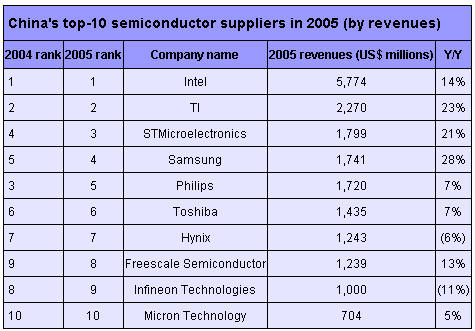STMicroelectronics and Samsung grow in China chip market, iSuppli says
Amid a dramatic slowdown in the growth of China's semiconductor demand in 2005, STMicroelectronics and Samsung Electronics managed to increase their chip market share in the nation for the year, according to a new top-10 ranking from iSuppli
Amid a dramatic slowdown in the growth of China's semiconductor demand in 2005, STMicroelectronics and Samsung Electronics managed to increase their chip market share in the nation for the year, according to a new top-10 ranking from iSuppli.
Europe-based STMicroelectronics moved into the third position in the China chip market in 2005, up from fourth place in 2004, with its semiconductor revenue in the nation increasing to US$1.8 billion, up 21% from 2004.
STMicroelectronics' strong performance was thanks to its successful restructuring as well as its gains in emerging product areas in China, such as digital set-top boxes (STBs). The company also benefited from the relatively weak performance of fellow European supplier Philips Semiconductors.
South Korea-based Samsung also advanced in the rankings in 2005, rising to the fourth spot, up from being fifth in 2004. Samsung's semiconductor revenues in China increased by to US$1.7 billion in 2005, up 28% from 2004, the largest percentage increase among the top-10 suppliers for the year. The company's rise was buoyed by its growing memory business and expanding market share in microcontrollers.
China's overall semiconductor demand reached US$37 billion in 2005, up approximately 12.8% from 2004, according to iSuppli's recently-published China Competitive Landscaping Tool (CLT). This figure is based on an iSuppli survey and analysis of the financial results of more than 150 semiconductor suppliers in China last year.
In contrast, China's semiconductor demand increased by 34.9% in 2004, indicating a drastic slowing of growth in 2005. China's semiconductor demand has enjoyed a brisk annual growth rate for about two decades, so it's not that surprising to see some slowing of the growth as the demand base expands.
Intel retained the first rank in China's semiconductor market, leveraging its leading position in PC microprocessors. Texas Instruments (TI) recorded higher growth in the digital signal processing (DSP), analog and logic markets, owing to its large and well-established customer base that now includes Nokia and Huawei.
Philips dropped to the fifth position in 2005, down from being third in 2004, and it appears that Philips' past strengths in selling analog parts for CRT-based monitors and televisions have become a liability as those markets have transitioned to LCD technology.
Japan's Toshiba posted mild growth in 2005 and maintained its sixth ranking. Toshiba has built a strong customer base in the domestic mobile-phone handset, television and white-goods markets. In contrast to other Japanese semiconductor vendors, Toshiba has been quite successful in China.
Declining growth rates in China was a significant trend among the major semiconductor suppliers in recent years. However, a large number of small and mid-sized chip suppliers, such as MediaTek, Trident, MStar and Actions, reported greater than 40% growth in China last year. These companies are becoming major drivers of fresh growth in the industry, and iSuppli expects their momentum will continue in 2006.
China's semiconductor demand was quite strong in the first quarter of 2006, and there were even many reports of supply shortages. However, in the second quarter, some inventory accumulated in the mobile-phone supply chain and for consumer-electronics goods, such as DVD players and digital STBs, which were mainly for export.
The Reduction of Hazardous Substances (RoHS) product certification process in Europe, effective as of July 2006, also has started to impact Chinese-made electronic goods for export. Meanwhile, China-based telecom carriers are reluctant to increase capital spending because the government has continued to delay the authorization of 3G-based service licenses. This means that major Chinese telecom equipment vendors must rely on export sales due to ongoing uncertainty in the domestic market.
iSuppli projects that China's semiconductor demand will increase by about 18% in 2006.

Source: iSuppli, compiled by DigiTimes, July 2006








